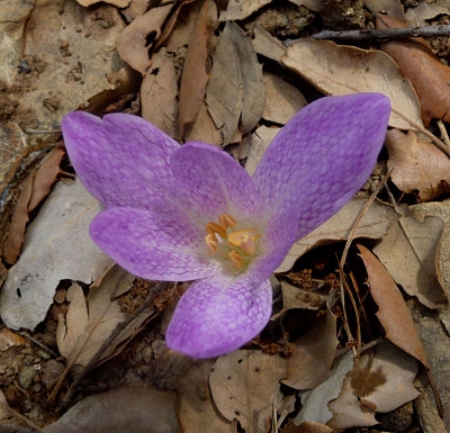Autumn crocus and the "golden spice"
/Colchicum Gail Hampshire/Flickr
Some plants you associate with a given season. Daffodils should bloom in April, roses in June, mums in September and October.
When you come upon a plant doing the right thing at the wrong time, it brings you up short. I’m thinking of plants like the Peruvian daffodil, a bulb that blooms in mid-summer, the autumn cherry, which blooms in May and then again in the fall.
None of the fall-blooming misfits are quite as startling as the autumn crocus, flowering among the falling leaves like a reprise of that first warm day in March. Like the early spring varieties, these crocuses sport chalice-shaped blossoms of white, purple, yellow and rose on plants ankle high.
To make things more interesting, the true fall crocuses are generally lumped with a look-alike plant of a different species, the Colchicum. With its name like an incipient sneeze, these look like a crocus on steroids, having a heftier flower and an altogether larger bulb.
The group also includes the bright purple saffron crocus (Crocus sativus), source of the spice associated with pharaohs and kings. Like Beluga caviar and the black truffle, saffron comes very dear. Rightly called the "golden spice," saffron goes for $100 per ounce; few things we eat carry a stiffer price.
It isn’t just that it’s imported from Spain, India, Pakistan and the Middle East. It’s that it takes so many little purple flowers to produce a usable amount of the dried spice. Saffron is the dried red stigma threads that sprout from stamens at the center of the blossom. These have to be hand-picked and separated (in the best-quality saffron) from the tasteless yellow stamens.
It takes some 200,000 stigmas from 75,000 crocus to make a pound of saffron, each pound accounting for about 200 hours of labor in planting, picking and curing. Suddenly the cost becomes much easier to understand, if no easier to swallow. It takes very little saffron to give recipes that golden color and pungent taste, though — $10 worth, about 1 gram, will cover a huge pot of paella, a hefty saffron chicken and a vat of saffron rice.
Saffron crocus Line1/Wikimedia
Known through antiquity, saffron was prized in ancient Egypt, where it figured among burial spices. The Phoenicians baked it into moon-shaped cakes eaten in honor of Ashtoreth, goddess of fertility; Persian women wore it to promote speedy deliveries and the Greeks sprinkled fragrant saffron water in public places like theaters and banqueting halls.
Belief in saffron’s beneficial properties persists to this day. In modern India, it is used to treat everything from arthritis to infertility, while throughout Asia and the Middle East, it is valued as an aphrodisiac. Obviously, this little flower has carried a lot of freight through the ages.
You can grow the saffron crocus in your own backyard, but don’t expect too much of your harvest, unless you plant large numbers. These bulbs are generally shipped in late summer or early fall and if planted right away (as they should be), will bloom a few weeks later. Mail order sources include American Meadows and White Flower Farm.
These plants like fertile, well-drained soil and full sun. Space about 3 inches apart and mark the spot so you don’t disturb the plants during dormancy. To try your hand at saffron production, pluck off the brightly colored stigmas with tweezers and dry before use. Then soak the stamens in water and add both the steeping liquid and the threads to your recipe.
By the way, be absolutely certain that what you have is the true C. sativus. Those look-alike flowers mentioned earlier, the Colchicums (sometimes called meadow saffron), are not just innocent impostors, but seriously poisonous. The root, which smells like a fresh radish, has been used in some cultures as strong medicine, but in large doses it can cause big problems with the kidneys and digestive system, bringing on "violent purging."
It’s not a matter of life and death, but in the spice section of your local market, beware of products sold as "American saffron" (really safflower) and "Mexican saffron," (derived from the annual herb Carthanus tinctorius). Both have color, but no taste. The best saffron of all comes from Kashmir, where the soil and climate produce flowers with extremely long stigmas of the richest, deepest red.


